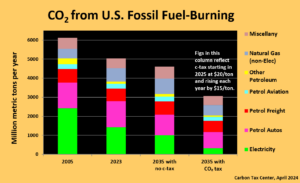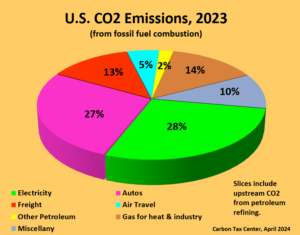The first major update of CTC’s carbon-tax model since 2021 is now in the books, calibrated to 2023 emissions and the putative emissions-reducing provisions of the Inflation Reduction Act. One result stands out: Without federal legislation mandating a robust national carbon tax, the U.S. won’t come close to achieving the hoped-for 50% decline in carbon emissions (from 2005 levels) in the reasonably foreseeable future.
A $20/$15 carbon tax could halve carbon emissions by 2035

A national carbon tax starting next year at $20/ton and rising annually by $15/ton will cut U.S. CO2 emissions in half from 2005 levels in 2035. To halve emissions by 2030 requires $25/ton for both the starting price and the annual rises.
A national carbon price that took effect in 2025 at $20 per (short) ton and rose by $15 per ton each year would, by 2035, halve U.S. emissions of carbon dioxide from fossil fuel combustion: from 6,120 million metric tons (“tonnes”) in 2005, the standard baseline year, to an estimated 3,068 million tonnes in 2035, according to CTC’s model (Excel spreadsheet, 2 MB). That computes to a 50% reduction (rounded from 49.9%).
[NB: The site hosting the Excel file is temporarily down, please check back soon.]
But without a national carbon price, our model projects U.S. emissions in 2035 of 4,606 million tonnes. That would be just 25% below 2005 emissions, putting the country only halfway to the 50%-reduction goal in 2035. And even that piddling progress entails pushing back the customary 2030 target for halving U.S. emissions to 2035, a 5-year delay.
To be fair, the “halving by 2030” goal is generally construed to encompass not just carbon dioxide but also methane, which is regarded as lower-hanging greenhouse-gas fruit on account of its relative concentration in more easily regulatable oil and gas extraction and transport. This January methane began to be subjected to emissions pricing, through a provision of the Inflation Reduction Act mandating that emissions above a certain threshold be taxed at a rate of $900 per tonne.
But even assuming an optimistic three-fourths reduction in methane and other non-carbon GHG’s, CO2 emissions from fossil fuel-burning would have to fall by 44% from 2005 to achieve an overall 50% reduction in U.S. greenhouse gas emissions. Without a national carbon price, the projected CO2 reduction from 2005 is just 17% in 2030 and, as noted, only 25% in 2035, according to CTC’s model.
Halving carbon emissions by 2030 requires a more heroic carbon tax, one starting at $25/ton in 2025 and rising annually by that amount
We also ran the CTC model to determine the carbon price level and trajectory required to halve U.S. 2005 carbon emissions by 2030 rather than 2035. Talk about a tall order! Here’s what the requisite carbon tax would look like:
- The carbon tax would take effect in 2025 (same as in the 2035 scenario).
- The initial price would be $25 per ton of CO2 rather than $20.
- The annual price rise would be the same $25/ton, rather than just $15/ton in the 2035 scenario. That means reaching triple digits in the tax’s fourth year.
- And — this is a bit technical — we’re relaxed the model assumption of the maximum annual tax rise to which the U.S. economy can fully react, from $20/ton previously to $25/ton.
It goes without saying that the present-day American political system isn’t equipped to enact and implement such an “heroic” (an adjective we prefer to “draconian”) carbon tax.
The still-lonely radical center
Prominent voices calling for carbon taxes beyond token amounts (e.g., $10 or $20 per ton with little or no increases) are precious few, not just in absolute terms but relative to the pre-2010 period in which climate concern was widespread and neither the left nor the right had been consumed by their respective demonizations: carbon pricing (on the left) or climate concern of any sort (on the right).
Indeed, here at Carbon Tax Center, we’ve traded in our web pages that previously celebrated carbon tax supporters for pages like Carbon Pricing and Environmental Justice, Progressives and Carbon Pricing, and Conservatives, all of them grouped under a heading of “Politics.” Each is essentially a litany of grievances and rejections of carbon pricing and/or climate action, period.

This chart, from CTC’s newly updated carbon tax model, shows the futility of looking for a single invention or regulation or subsidy to slash U.S. emissions. Fossil fuels suffuse our economy, making robust carbon pricing essential to achieving big across-the-board cuts.
This isn’t polarization, it’s a simultaneous disavowal by both ends of the political spectrum of the lone plausible transformational climate-preserving policy measure. (Rather than “ends” I should say “sides” of the spectrum, given that anti-pricing has spilled over from the confines of the respective extremes and now appears to occupy most of the two sides.)
Omens
Consider these two minor but telling signposts from the past week.
One was a NY Times “Sunday Review” guest essay last weekend, I’m a Young Conservative, and I Want My Party to Lead the Fight Against Climate Change, by one Benji Backer, founder-director of the American Conservation Coalition.
Alas, the essay was cut from the same generic cloth as other conservative calls to climate action. Here’s an excerpt:
We cannot address climate change or solve any other environmental issue without the buy-in and leadership of conservative America. And there are clear opportunities for climate action that conservatives can champion without sacrificing core values, from sustainable agriculture to nuclear energy and the onshoring of clean energy production.
Ho-hum. But, most strikingly, zero mention of carbon pricing — not even a nod to the revenue-neutral type such as fee-and-dividend that circumvents right-wing canards about government overreach by “dividending” the carbon revenues to households, thus correcting the market failure driving carbon emissions without “growing the government.”
So much for the right wing. On the left, I had the frustrating experience of meeting a director of an iconic American environmental organization at a public event and bonding with him over our shared dismay at the organization’s post-2016 submission to anti-carbon-pricing rhetoric . . . only to be ghosted when I tried to arrange a meet-up to possibly grow our newfound patch of common ground.
So much for dialogue in service of effective climate policy.
Can’t we bring U.S. emissions down sharply without carbon pricing?
Alas, no. U.S. emission progress perennially falls short of even modest hopes. Almost from the moment the 2022 Inflation Reduction Act — which CTC supported from the git-go — was enacted into law, it has bumped up against a calamity of transmission bottlenecks, supply-chain woes and high interest rates. Even worse, perhaps, is the legal-regulatory “default” against building almost anything, even essential elements of the clean-energy infrastructure the IRA was intended to unlock
(Just after this post went up, I came across NY Times columnist Ezra Klein and Atlantic staff writer Jerusalem Demsas’s trenchant dive into the permitting-resistance phenomenon. Their analysis traces much of today’s disabling red tape and NIMBYism to Democratic Party empathy that prioritizes concerns about marginalized constituencies over the common good. Audio version here, transcript here.)
And let’s not overlook the emergent hellspawns of energy demand like AI processing, cyber-currency computing and ever-larger SUV’s and pickup trucks driven ever more miles, all of which threaten to pile on new carbon emissions almost as fast as incumbent emissions are removed.
As we’ve argued in post after post — just scroll through our monthly archives — these and other decarbonization derailments would be greatly alleviated by the robust carbon taxes we scoped above. Pricing the climate benefits of reduced fossil fuel use into the vast array of alternatives — from clean energy to all the ways of using less — will raise their profitability and, before long, bend society’s defaults toward replacing fossil fuels.
Our updated carbon-tax model shows that U.S. carbon emissions fell by 2.3% from 2022 to 2023. If there weren’t a climate emergency, that might qualify as a decent win. But in our real, overheating world, that rate doesn’t come close to the 4.1% compound annual decline needed to halve 2005 emissions by 2035, much less the 6.9% annual emissions shrinkage required to meet the same goal in 2030.
The insufficiency of even the best-intentioned policies and programs to meet necessary carbon targets without robust carbon taxing can’t be hidden indefinitely. The carbon tax reckoning awaits.

[…] Read MoreDid you miss our previous article… https://www.carbons.market/climate-action-policies/diary-of-a-transit-miracle/ […]